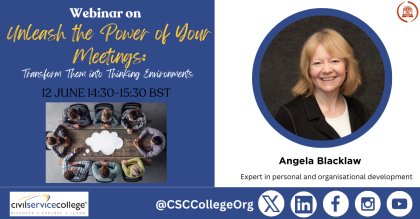Written by Ben Yardley, Learning Coordinator
What’s the best way to get everybody’s input during a meeting?
How do you create egalitarian and safe environment where strong personalities don’t get in the way of thoughtful discussion?
And (importantly!) when should a meeting be an email?
Drawing on her experience as a trainer and a former civil servant, Angela Blacklaw answers these questions and more in Civil Service College’s June webinar, which shows you how to supercharge your meetings, engage your colleagues and foster an environment where everybody’s opinion matters. By using the Thinking Environment methodology, you can turn your meetings from a chore into a productive and effective exercise.
Holding Meetings: what can go wrong?
We all value our time, and the time of our colleagues. But despite this, in any organisation, it is easy to feel that the meetings we attend are too often ineffective and time-consuming.
Before discussing how we can hold meetings more effectively, Angela Blacklaw invited the audience to share what’s holding them back. The responses are familiar:
- Lack of agenda
- An agenda that is too vague, or one that is shared before the meeting but not followed.
- Meetings taking too long
- Ineffective chairing
- Groupthink
- Meetings becoming dominated by a small group, to the point of excluding other participants
Creating a Thinking Environment
According to the author and coach Nancy Kline, “The quality of everything we do depends on the quality of the thinking we do first”. This is why it is so important to make sure that all meetings are a space for quality thinking. Techniques such as creating a clear structure for meetings and making a point of giving every participant a chance to speak on each agenda item, can help to build a safer and more constructive environment, where all voices are heard.
Angela Blacklaw also highlighted the importance of keeping meetings interruption free, even if it means asking a more senior colleague to take a pause and allowing someone else to speak freely. When we are interrupted it is not just our speech that is cut off, but also our thinking. The aim, she says, is to nurture an environment in which “difference of thinking is not just tolerated, it is welcomed, it is sought after”. This leads to hearing more from quieter employees and a better working environment
Meeting with purpose
Before calling a meeting, it is essential to reflect on what you want to achieve, and whether these aims are best accomplished by holding a meeting; as one example, if you are sharing a fact or giving an instruction, sending an email might be quicker and more effective. Meetings should ideally be collaborative, with space for every participant to give their views.
Another method for holding meetings with a clear purpose is to set a clear agenda in advance and to delegate responsibility to somebody who can make sure everybody sticks to the plan! Facilitating a meeting does not mean you are obligated to drive the conversation forward yourself; instead, it means you have a responsibility to make the discussion easier for everyone, keep the conversation relevant and to give everybody a chance to speak. Angela points out that even a device as simple as framing each agenda point as a question, rather than a broad topic, can help everybody in a meeting to focus on a shared goal.
Lastly, the best way to maintain a Thinking Environment is to be mindful of the needs of everybody attending. No matter your role, Angela suggests that you ask, “am I doing enough right now to create an environment where the person speaking right now can flourish?”.

